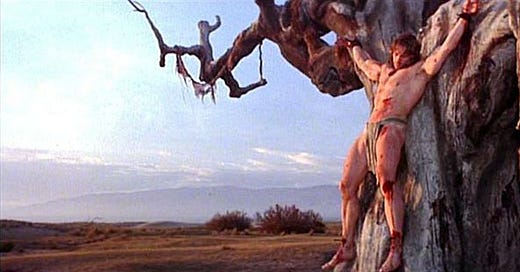John Milius’ Conan the Barbarian (1982) is an operatic regurgitation of myth and history with a subversive message. It’s a seminal, must-watch film.
Operatic
The best filmmakers eschew dialogue for montage in telling their story, and Milius pushes broad-stroke imagery to the limit here. The raid on Conan’s village, the wheel of pain, the gladiator pit, the tower of the serpent, the tree of woe, and others serve as markers of a mythical coming of age. Lingering images are made fully operatic by the meticulous score of Milius co-conspirator Basil Poledouris. Dialogue is unimportant in this sparse meditation on a Nietzschean ubermensch journeying from victim to victor. Voiceover about “the riddle of steel” serves as ironic counterpoint to a hero made strong by will alone, triumphing with a broken sword.
Few films aspire to operatic qualities and fewer achieve them. Excalibur, filmed at the same time as Conan, had such aspirations but fell short. The message was muddled and the ending ridiculous. Wagner leitmotifs overshadow the action on screen. Milius actually decided to not use Carmina Burana (Orff) after hearing Boorman was going to use it in Excalbur. Poledouris adapted it to a toned-down version that maps beat for beat to the village raid in Conan. The result is more visceral, better integrated.
Subversive
Nietzsche might be a tad subversive, but Milius needs to be certain of your outrage, so he jokingly weaves in a warning against hippies/cultists. Conan pretending to be a flower child. Thulsa Doom beckoning a hippy chick off the ledge while arguing variations against the riddle of steel. There’s plenty of sly food for thought about the dangers of modern leftist groupthink. Hollywood must have hated that - so production was farmed out to Dino De Laurentis, who gave Milius a big budget and free reign. The result is a rarity: a blockbuster film that stands in stark opposition to the Hollywood establishment. Compare again to Excalibur, which lamely injects environmentalism into its ending.
Performances
Yes, Conan the Barbarian is a masterpiece but not without flaws. The acting is mostly bad, with notable exception James Earl Jones as Thulsa Doom. Jones’ Doom can mesmerize a foe to stillness in order to more easily lop their head. He can beckon a follower to jump to her death. It’s a great performance.
Arnold Schwarzenegger could barely speak english, but this forced Milius to characterize Conan visually, with good results. The few lines Arnold has are rehearsed to passable. Who can forget Arnold struggling through the old Genghis Khan quote: “To crush your enemies, to see them driven before you, to hear the lamentations of their women: these are best in life”?
Sandahl Bergman’s overly precocious attempt at Conan’s love interest ruins a few scenes. Milius pal Gerry Lopez brings nothing to his role as Conan’s pal Subetai (another nod to the Khan). These flawed performanes drag Conan down in the second act.
Legacy
Conan was a commercial success which spawned the unremarkable sequels Conan the Destroyer and Red Sonja. A 2011 “reboot” starring Jason Momoa discards opera of the original in favor of kinetic ballet of a sort popularized by films like 300. Unlike 300, it can’t fully commit to the dance and ends up being a typical Hollywood mass-market mess. Sad, because Momoa could have made a great Conan.
John Milius’ absence is keenly felt.




